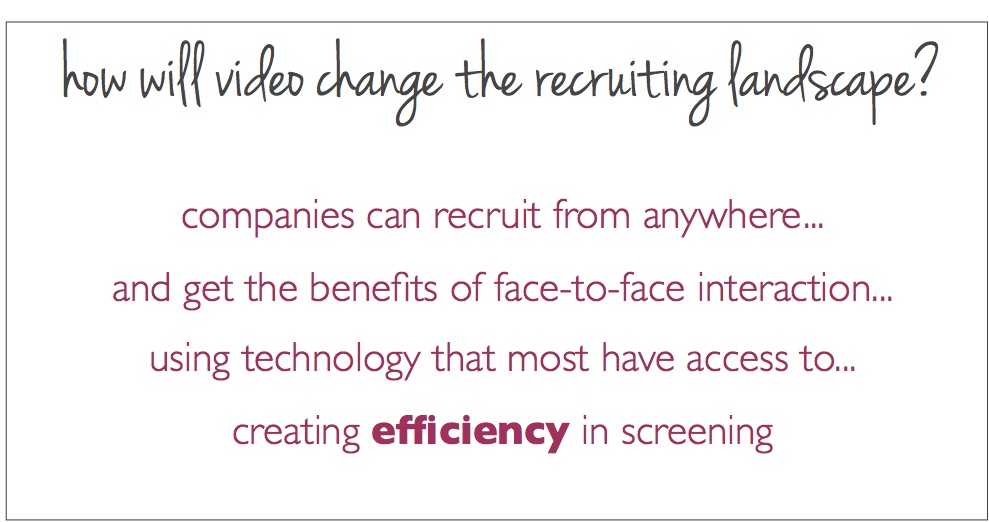I spend a lot of time thinking about is how the recruiting landscape is going to change in the coming years. How will technology change an industry that is somewhat set in it’s ways? There is no doubt that new technology can help make major strides in the recruiting world – strides that will make every recruiter’s role more efficient and every candidates experience more streamlined.
One of the major shifts I’m noticing has to do with the use of video in the interview process. Obviously having video accepted as a tool is great for many reasons:
1. You can have that face-to-face interactions with non-local candidates. From an expense and logistics point of view, interviewing candidates who are not local has gotten a lot easier. In the past, companies may have limited their candidate pool to local candidates because of cost reasons. Now, with video being so accessible (and accepted), that location barrier has somewhat fallen.
2. With smartphones being as common as they are, most people have the ability to actually DO a video interview. You can download Skype to almost any smartphone (with a video camera) and obviously FaceTime now comes standard on the iphone. As an interviewer that means I can simply prop my own iphone up on my desk and do the video call with headphones (vs. booking a conference room with video capabilities). For the candidate, that means they can take the interview almost anywhere with wifi (not every location is recommended, but it’s possible).
3. It can be more efficient for a first interview or an initial screen. Believe it or not, scheduling a simple half hour in-person interview can take close to an hour of time. Getting on the same page in terms of schedules, confirming times, booking conference rooms, etc. are things that add to the logistics of interviewing someone in person. If you are casting a wide net on the initial screen, doing a 15 minute skype or facetime will ultimately help recruiters narrow down the pool with a lot less logistics. Maybe after that video screen you bring in the top 3 people instead of all 10 candidates who qualify on paper.
This 3rd point is the one I am most excited about from a recruiting perspective because I love efficiency. In the past I’ve used phone screens for a similar purpose (of narrowing down) but you just get so much more with a face-to-face interaction. Often people think this is because recruiters are judging appearance… but it’s not. For me personally it’s always been about being able to watch people react to a question and see their faces light up when they are passionate about something.
However, some incredibly smart people are taking it a step further. What if you didn’t even have to reach out and schedule the video screen? What if candidates could record a video as part of their application process? Yes, please! In terms of the early screens, recruiters often have the same types of questions for candidates such as “why are you interested in this role?” & “what would make you good at it?”.
Businesses such as Take the Interview will allow employers to set up their go-to questions and then have certain (or all) applicants answer them via video. From there, they can review the videos and select the candidates they’d like to move forward in the process. While I think some companies may not be slower to move to this method, I do believe that video based screening (even before contact with the recruiter) is going to be prominent in the near future. It will save the company’s time and in turn, will save your time. I expect to see this type of tool being used by more and more companies in the next few years.
What does that mean for you as candidate? Start to get comfortable behind that video camera! It is only a matter of time before things like your LinkedIn profile becomes interactive as well.






